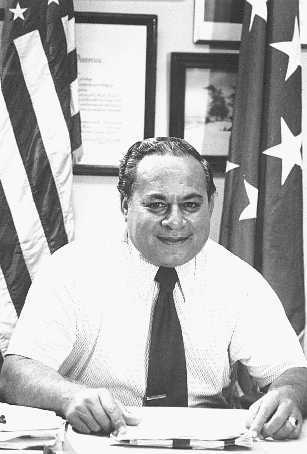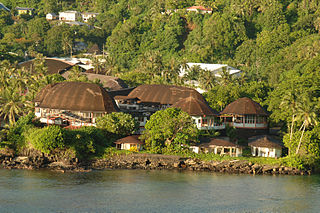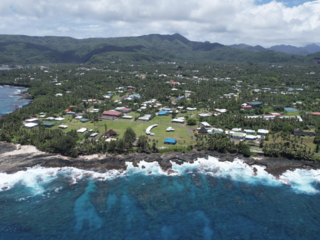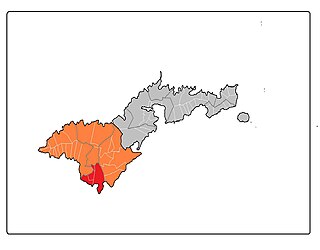
Peter Tali Coleman was an American Samoan politician and lawyer. Coleman was the first and only person of Samoan descent to be appointed governor of American Samoa between 1956 and 1961 and later became the territory's first and third popularly elected governor from 1978 to 1985 and 1989 to 1993, serving a total of three elected terms. In between, he had served in different administrative positions for Pacific islands.

American Samoa Community College (ASCC) is a public land-grant community college in the village of Mapusaga, American Samoa. Only legal residents of American Samoa who have graduated from high school or obtained a General Equivalency Diploma are admitted to ASCC.

The American Samoa House of Representatives is the lower house of the American Samoa Fono. The House consists of 21 members serving two-year terms, with 20 popularly elected representatives, and one delegate from Swains Island elected in a public meeting.
Utulei or ʻUtulei is a village in Maoputasi County, in the Eastern District of Tutuila, the main island of American Samoa. Utulei is traditionally considered to be a section of Fagatogo village, the legislative capital of American Samoa, and is located on the southwest edge of Pago Pago Harbor. Utulei is the site of many local landmarks: The A. P. Lutali Executive Office Building, which is next to the Feleti Barstow Library; paved roads that wind up to a former cablecar terminal on Solo Hill; the governor's mansion, which sits on Mauga o Alii, overlooking the entrance to Goat's Island, and the lieutenant governor's residence directly downhill from it; the Lee Auditorium, built in 1962; American Samoa's television studios, known as the Michael J. Kirwan Educational Television Center; and the Rainmaker Hotel. Utulei Terminal offers views of Rainmaker Mountain.

The Seal of American Samoa is based in traditional local design.

The American Samoa Department of Public Safety, formerly the American Samoa Territorial Police, is the police law enforcement agency for American Samoa, which has jurisdiction anywhere in the territory. It was created to protect the lives and property of American Samoans. The DPS has police, corrections and fire divisions.

Leone is the second-largest city on Tutuila Island's west coast. The village is on the south-west coast of Tutuila Island, American Samoa. Leone was the ancient capital of Tutuila Island. Leone was also where the Samoan Islands’ first missionary, John Williams, visited on October 18, 1832. A monument in honor of Williams has been erected in front of Zion Church. Its large church was the first to be built in American Samoa. It has three towers, a carved ceiling and stained glass. Until steamships were invented, Leone was the preferred anchorage of sailing ships which did not risk entering Pago Pago Harbor. Much early contact between Samoans and Europeans took place in Leone.

The American Samoa Power Authority (ASPA) is a government-run public utility company providing electricity, water, wasterwater, and waste disposal services within American Samoa.
Anua is a village on Tutuila Island, American Samoa. It is located close to the capital Pago Pago, on the coast of Pago Pago Harbor. The term Pago Pago is often used for several settlements on Pago Pago Bay, including Anua, Lepua, Utulei, and others.
Fagaʻalu is a village in central Tutuila Island, American Samoa. It is also known as Fagaʻalo. It is located on the eastern shore of Pago Pago Harbor, to the south of Pago Pago. American Samoa's lone hospital, Lyndon B. Johnson Tropical Medical Center, is located in Fagaʻalu. The village is centered around Fagaalu Stream.

Rainmaker Hotel was a 250-room luxury hotel in Utulei, Pago Pago, American Samoa. It was the only proper hotel in American Samoa and was operated by the government. The hotel was at its peak in the 1960s and 1970s, when it was known as the Pacific's Intercontinental Hotel.
Samoana High School (SHS) is a prominent high school in Utulei, a community in Maoputasi County, Eastern District, American Samoa. It is a part of the American Samoa Department of Education.

Leone High School is a senior high school in Vailoatai and Leone, in the Western District, American Samoa. It is operated by the American Samoa Department of Education. It is the second-largest high school on Tutuila Island.
The Samoa News is a newspaper published in Pago Pago, American Samoa. In 1981, Samoa News was the major newspaper distributed in both of the Samoas. In January 1985, Lewis Wolman became editor of Samoa News. The Samoa News Ltd. was established in 1986, with Fuga Teleso as the majority shareholder. Wolman purchased Teleso's shares on November 18, 1986, and became the publisher-editor for Samoa News. It began printing on a web press in December 1989, allowing for an increase in paper size. In January 1990, it became the first daily newspaper in America Samoa, printed at its new facilities in the downtown Pago Pago location in Fagatogo. Fuga Tolani Teleso was chairman of the board.
The Governor H. Rex Lee Auditorium, also called Fale Laumei in Samoan, is the largest indoor meeting space in the United States territory of American Samoa. It is located in the village of Utulei, surrounded by other government buildings. The main body of the building is a roughly ovoid structure, with a curved roof that is reminiscent of the thatch roofs of traditional Samoan structures. The auditorium was built in 1962 under orders from Governor Hyrum Rex Lee as part of a major initiative to modernize the territory's infrastructure and facilities. It was built by a construction squadron of the United States Navy, and was completed in time for the 1962 South Pacific Conference. It was later named in honor of Lee, who was the territory's longest-serving governor, and oversaw much of its modernization.
Fagaoalii Lefagaoali'i Satele Sunia was an American Samoan literacy advocate and educator. She served as the First Lady of American Samoa from January 1997 to March 2003 during the tenure of her husband, former Governor Tauese Sunia, who died in office in 2003. Sunia established and operated the Read to Me Samoa Program to promote reading in American Samoa. She also created the Tauese P. Sunia Memorial, a museum and visitor attraction dedicated to her late husband located at her home in Tutuila.

Vailoatai is a village in southwestern Tutuila, the main island of American Samoa. It is located on the eastern end of Leone Bay. The village is known for its beautiful malae, nested along the island's rugged southern coast and lined by the fale tali mālō of its village chiefs.
Pavaʻiaʻi is a village in the Western District of Tutuila Island in American Samoa. It borders Mapasagafou and Faleniu to the north, ʻIliʻili to the east, Futiga to the south, and Malaeloa to the west. It is located in Tuālāuta County.

Tuālā-tai County is one of the five counties that make up the Western District of American Samoa.
Itūʻau, together with Aitūlagi, make up the village of Malaeloa.











